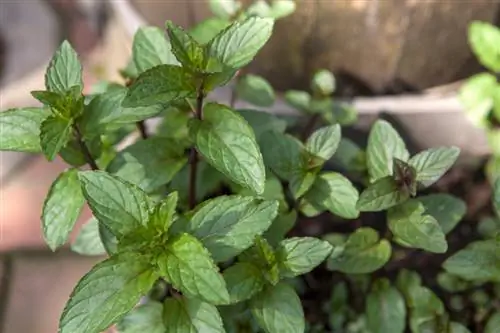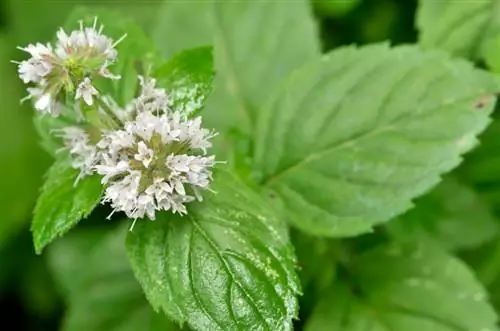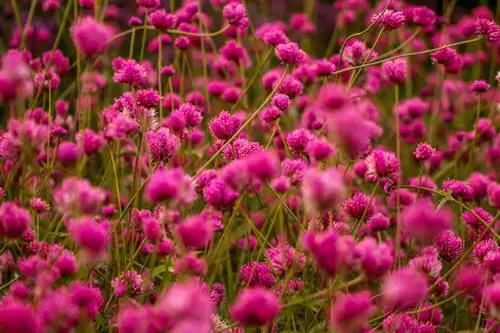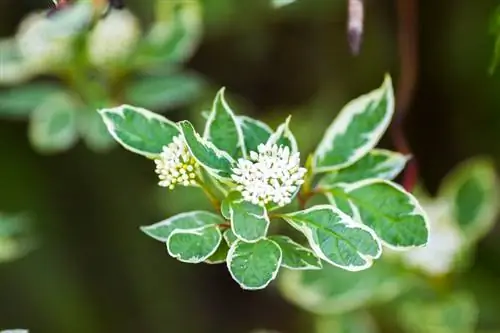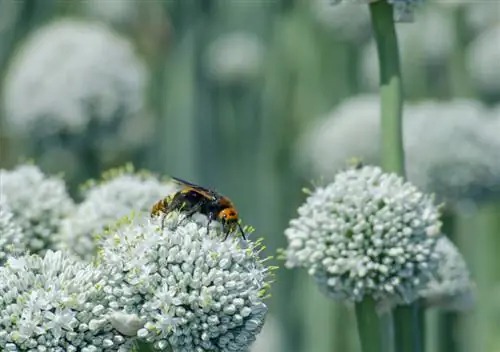- Author admin [email protected].
- Public 2023-12-25 17:45.
- Last modified 2025-01-23 11:22.
As a succulent ornamental plant with summer flowers in magical colors, stonecrop has won our sympathy. The perennial of 2011 is good-naturedly forgiving of many a beginner's mistake. If you are still wondering about questions about correct planting and professional care, these answers will provide you with useful information.
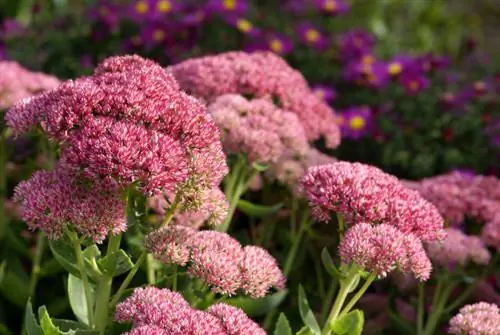
What is important for caring for sedums?
The sedum, also known as stonecrop, is an easy-care, winter-hardy, perennial succulent. It requires a sunny location, well-drained, sandy-dry soil and moderate watering. The plant is suitable for beds, rock gardens and pot culture and can be easily propagated by division or cuttings.
Planting stonecrop correctly
So that stonecrop can fully exploit its strengths, the following aspects are relevant when planting:
- The sunny location has permeable, humus-rich and sandy-dry soil
- No compost or other fertilizer is added to the potting soil
- The planting depth corresponds to that in the cultivation pot
- Water the stonecrop just a little after planting
If you have concerns about the required permeability, optimize the soil with sand or grit and spread a drainage system at the bottom of the planting pit with small shards of clay or grit.read more
Care tips
The closer the chosen location is to the ideal conditions, the less effort it takes to care for stonecrop.
- Wate the ornamental plant in the bed only when there is no rain
- Use collected rainwater or decalcified tap water
- Fertilizing is not necessary in the bed
- Protect stonecrop with coniferous twigs when it is constantly wet in winter
- Prune in early spring by a maximum of two thirds
Do not water the planting bowl until the thumb test indicates a dried substrate. From April to September, apply a half-strength liquid succulent fertilizer every 6-8 weeks. So that the root area in the planter does not freeze in winter, stonecrop moves to winter quarters in autumn. In a bright window seat at temperatures of 5-10 degrees Celsius, water only enough to prevent the plant from drying out.read more
Which location is suitable?
The exotic ornamental plant perfectly showcases its visual appeal in a full sun to sunny location. A few exceptions tolerate partial shade, such as the purple carpet sedum. There is widespread agreement among stonecrop species when it comes to soil requirements. The soil should be loose, well-drained, sandy-dry and lean, with a pH value of around 7.read more
The correct planting distance
Since stonecrop gives us species and varieties of different heights and widths, the planting distance should be tailored to the respective ornamental plant. We have put together recommended distances for you for the most common stonecrops:
- Growth height 10-20 cm: planting distance of 20-25 cm
- Growth height 20-30 cm: planting distance of 30 cm
- Growth height 40-50 cm: planting distance of 45 cm
What soil does the plant need?
Sedums prefer well-drained soil that is not too rich in nutrients. An excess of nitrogen, phosphorus, potassium and trace elements impairs the stability of tall stonecrop species in particular. Therefore, choose a sandy-gravelly soil texture, such as that which dominates in rock gardens and gravel beds. In plant bowls, the bizarre ornamental plant achieves its optimum in loose succulent soil or a mix of potting soil, sand and lava granules. Also take a look at the soil acidity, as a pH value of 6.5 to 7.3 is considered beneficial.
What is the best time to plant?
You can plant a sedum you have grown yourself or purchased ready-made in the ground throughout the entire gardening season. A date in spring or autumn is wisely chosen. Planting should only be avoided under extreme weather conditions, such as frost or summer heat.
When is flowering time?
Although the flowers on stonecrop visually recede behind the striking foliage, they still underline the impressive appearance of stonecrop. Depending on the species and variety, the flowering period of the ornamental plant extends from June to August or July to September.read more
Cut the stonecrop correctly
As a wintergreen ornamental plant, stonecrop drives away sadness from the garden with its eye-catching foliage. In addition, stonecrop offers insects and other beneficial insects a sought-after retreat. Therefore, do not cut the perennial back in autumn. Leave the decorative medicinal plant in the bed until late winter and then remove dried leaves and unsightly stems. Radical pruning close to the ground prevents numerous species and varieties from sprouting again. Therefore, shorten shoots that are too long by a maximum of two thirds.read more
Watering the stonecrop
As a prime example of a succulent ornamental plant, stonecrop cannot even begin to tolerate waterlogging. Only water sedums when the substrate has dried out. It is preferable to use collected rainwater or stale tap water, as all Sedum species react sensitively to excess lime.
Fertilize stonecrop correctly
Cultivated in normal garden soil, there is no need to add additional nutrients. Compost and mineral fertilizer actually impair the desired compact growth. In very lean rock garden soil or on the roof garden, an organic starter fertilization in March/April is completely sufficient. In the limited substrate volume of the pot and balcony box, you can compensate for used nutrients by administering cactus fertilizer at half the concentration every 6 to 8 weeks from March to September.read more
Diseases
It is rare to complain about stonecrop diseases. A weakened ornamental plant is susceptible to stem and root rot caused by fungal spores. If brown spots spread on the medicinal plant while the perennial loses its stability and tips over, there is unfortunately no way to save it. Dispose of the infected sedum in the household waste and clean all tools carefully.read more
Pests
The fleshy leaves of stonecrop attract the voracious black-mouthed weevil. The infestation can be recognized by round and semi-circular eating marks. Since this pest also lays its eggs near the roots so that the larvae can feast on them, there is an immediate need for action. You can fight both the adult beetles and their brood with nematodes, which specialist retailers have available for you.
Wintering
Among the more than 420 species, the sedum genus offers us a variety of hardy plants. When purchasing a young ornamental plant for the garden, look for stonecrop that is suitable for outdoor use, as it is usually hardy down to -20 degrees Celsius. A protection made from needle twigs is only recommended in the bed when it is constantly wet in winter. Stonecrop thrives better in a pot or balcony box in a bright, frost-free winter quarters. Thanks to this caution, you avoid the risk of the sensitive root ball freezing.read more
Propagate stonecrop
One of the numerous advantageous attributes of stonecrop is that it is very easy to propagate. In early spring, take the spade and cut off a piece of at least 2 shoots from the carpet or clump. At the new location or in the pot, plant the segment in poor soil where it will quickly take root. A tall sedum also provides vital head cuttings that you can root in the water of a vase. Planted in lean herb soil or in a sunny rock garden, your little one will be transformed into a magnificent ornamental plant in no time.read more
How do I transplant correctly?
If you decide to change the location of stonecrop, spring is the best time to transplant it. Loosen the root ball all around with the digging fork to lift the rhizome out of the soil. Take this opportunity to subject the roots to a thorough inspection to cut out any stunted or rotten parts. Plant the ornamental plant in the new location just as deep as before and water it a little. Pruning by at least 30 percent compensates for the lost root volume.
Sedum in a pot
The deep pot is less suitable for stonecrops and the shallow bowl is more suitable. Since the extraordinary ornamental plant develops a marginal root system or a delicate rhizome, it does not require an extensive substrate volume for cultivation in a planter. Spread a layer of coarse sand or lava granules on the ground above the water drain as drainage. Cactus or succulent soil is ideal for undemanding ornamental plants. Only water stonecrop if it is dry for a long time. Fertilize with liquid cactus fertilizer every 6-8 weeks from April to September. If winter is just around the corner, stonecrop moves to the bright windowsill to hibernate there at 5-10 degrees Celsius. Ideally, the ornamental plant should be trimmed by up to two thirds in early spring.
Is stonecrop poisonous?
The information center for poisoning at the University Hospital of Bonn classifies stonecrop as a mildly poisonous plant. The low content of isocitric acid and malic acid is considered to be of concern, as it can lead to mild symptoms of poisoning if consumed. Therefore, do not allow curious children and pets within reach of this ornamental plant.read more
How do I care for sedum as a houseplant?
As a houseplant, stonecrop transforms simple plant pots into exotic eye-catchers, decorates the window sill in the flower pot or lets its tendrils dangle elegantly from the hanging basket. Thanks to stonecrop, even hobby gardeners with limited time capacity don't have to go without green room decoration, because care is so uncomplicated:
- A bright location on the southwest or southeast window at 18-22 degrees Celsius is ideal
- Water the ornamental plant moderately with rainwater if the substrate has dried out
- Administer liquid cactus fertilizer (€7.00 on Amazon) every 6-8 weeks from March to September
- From October to February, keep it cooler at 5-10 degrees, water less and do not fertilize
In early spring, thin out the ornamental plant thoroughly and cut back shoots that are too long by a maximum of two thirds. If the container is completely rooted, repot the sedum in loose cactus soil or a potting soil-sand mixture with a pH value of 6.5 to 7.3.read more
Does stonecrop have healing powers?
Regardless of its low toxic content, stonecrop has made a name for itself as a medicinal plant. Prepared as a tea, stonecrop prevents vitamin C deficiency and high blood pressure. However, the medicinal plant may only be consumed internally in minimal doses to avoid unpleasant side effects. Applied externally, sedum relieves painful skin irritations and is effective against warts and corns.
Beautiful varieties
- Variegatum: Variegated fat leaf with white-edged foliage and orange mini flowers; Growth height 10-20 cm
- Bertram Anderson: Stunning purple stonecrop with plum foliage and pink flowers; Growth height 10-15 cm
- Robustum: Ideal intermediate between low and tall sedums with carmine-red summer flowers; Growth height 20-25 cm
- Euphorbioid Maximum: A large golden sedum with a royal appearance and yellow flowers; Growth height 30-40 cm
- Carbuncle Stone: Premium variety with dark foliage and flowers that sparkle like red gemstones; Growth height 40-50 cm
- Matrona: Reaches a mighty height and is still stable with green foliage and pink flowers; Growth height 60-70 cm


